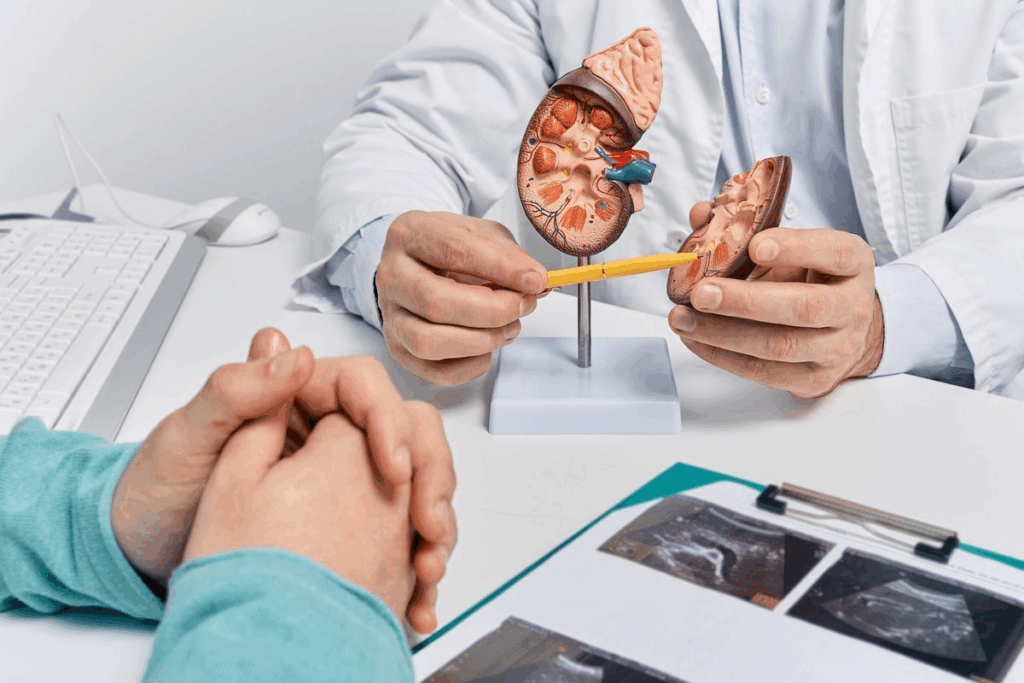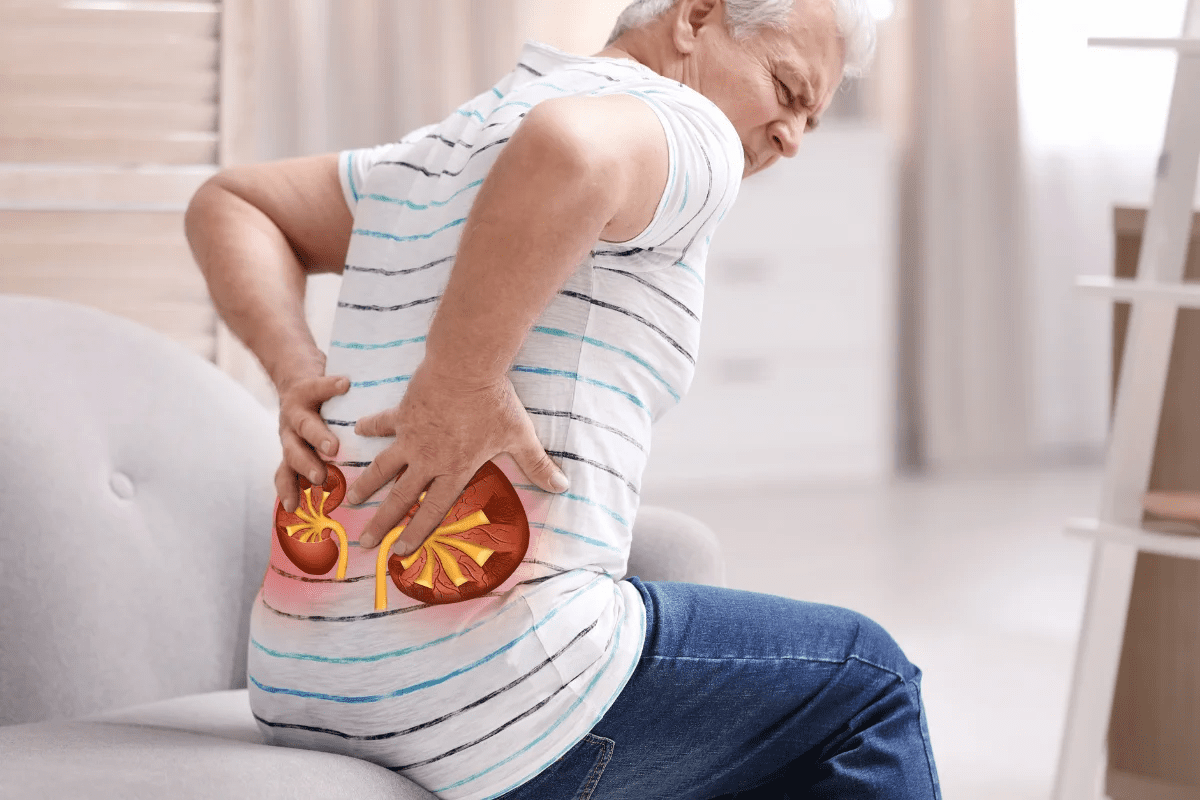Last Updated on October 31, 2025 by Bilal Hasdemir

Passing a kidney stone is painful and stressful. Knowing the stages can make it less uncomfortable and less worrisome.
We will walk you through the process. From the stone’s formation to when it passes.
Learn the 4 stages of passing a kidney stone. What to expect, and what happens when a kidney stone stuck in bladder causes symptoms.
Kidney stones are hard deposits that form inside the kidneys. There are several types, each with different causes and risk factors.
Calcium stones are the most common type. They often form in diets high in oxalate or low in calcium.
Uric acid stones are linked to dehydration and diets high in animal protein.
Understanding the type of kidney stone is key for effective management and prevention.

Kidney stones can cause a range of symptoms, from mild to severe. The main symptom is severe pain. This pain is often sharp or stabbing and can be felt in the side or back, below the ribs.
This pain can also spread to the lower abdomen or groin area.
Other symptoms may include nausea and vomiting.

There are many ways to treat kidney stones. The best treatment depends on the stone’s size, location, and the patient’s health.
Pain management, staying hydrated, and surgery are common treatments. Sometimes, ESWL is also suggested.
Keeping your kidneys healthy starts with what you eat and drink. Knowing why kidney stones happen and how to stop them is key. This way, you can lower your risk.
Dietary Recommendations are very important. Eating lots of fruits, veggies, and whole grains is good. But, try to eat less of foods high in oxalate, sodium, and animal protein.
Drinking enough water is also vital. It makes your urine less concentrated, which helps prevent stones. Aim for eight glasses of water a day. Drink more if you’re active or live in a warm place.
Other lifestyle changes can also help. Keeping a healthy weight, exercising, and managing stress are all good. These habits can make a big difference.
By making these changes, you can greatly lower your chance of getting kidney stones. Always talk to your doctor, too, if you’ve had stones before.
Drinking plenty of water is key to preventing kidney stones. Try to drink at least 8-10 glasses a day. Also, cut down on sodium to lower your risk of getting stones.
Eating foods rich in calcium is good too. Dairy and leafy greens are great options. A balanced diet with the right foods can help keep your kidneys healthy.
Steer clear of foods high in oxalate, like spinach and beets. Making smart food choices can help prevent kidney stones.
Managing kidney stone pain requires a detailed plan. This includes using medication for pain relief, drinking plenty of water, and sometimes, medical procedures. These steps help reduce pain and aid in passing the stone.
Kidney stones can cause serious problems if not treated right. One big risk is obstruction. This happens when a stone blocks the urinary tract. It leads to a lot of pain, nausea, and vomiting.
Stones can also raise the chance of infection. Bacteria grow in the urine, causing infection. If not treated, this infection can spread and become very dangerous.
Having many or big kidney stones can harm your kidneys for good. This damage might lead to chronic kidney disease or even kidney failure. You might need ongoing medical care.
Other issues include getting urinary tract infections again and again. You might also need surgery to remove the stone or fix any damage to the urinary tract.
When simple treatments don’t work, doctors may need to step in. The choice of treatment depends on the stone’s size, location, and type. It also depends on the patient’s health.
There are several treatments available. These include shock wave lithotripsy, ureteroscopy, and percutaneous nephrolithotomy. These methods aim to ease symptoms, remove the stone, and prevent future problems.
SWL is a non-invasive method. It uses shock waves to break the stone into smaller pieces. This treatment works best for stones 2 cm or smaller in the upper urinary tract.
Ureteroscopy involves a small scope inserted through the urethra and bladder. It reaches the ureter. This allows doctors to see the stone and remove or break it down.
PCNL is used for larger stones. It involves a small incision in the back. A nephroscope is inserted to access the kidney.
Knowing about these treatments helps patients make better choices. They can get the right care for their kidney stones.
Healthy habits can help prevent kidney stones. Staying hydrated is key. Drinking lots of water dilutes urine, making it harder for stones to form.
Drink at least eight glasses of water a day. Eating foods with lots of water can also help. Increasing fluid intake is a simple yet effective strategy for preventing kidney stones.
Diet changes are also important. Eating less sodium can lower calcium in urine, reducing stone risk. Try to avoid foods high in sodium, like processed snacks.
Eating fruits, vegetables, and whole grains is good for your health. Foods high in oxalate, like spinach, should be eaten in small amounts if you’re prone to certain stones.
Regular exercise is another key change. It boosts health and lowers kidney stone risk. Aim for 30 minutes of brisk walking a day.
Managing kidney stones requires a detailed plan. It includes knowing the symptoms, understanding treatment choices, and taking steps to prevent them. Being well-informed and proactive can help lower the risk of kidney stones. It also boosts overall health.
The stages include the stone forming, moving through the urinary tract, and passing out of the body.
Passing a kidney stone can take a few days to a few weeks. It varies from person to person.
Symptoms include severe pain in the side or back, nausea, vomiting, fever, and trouble urinating.
You can try over-the-counter pain meds like ibuprofen or acetaminophen. Sometimes, a doctor may prescribe stronger pain meds.
Yes, you can prevent them by drinking lots of water, eating a healthy diet, and managing health conditions.
If you think you have a kidney stone, see a doctor right away. They can diagnose and treat it.
Doctors use X-rays, CT scans, or ultrasounds to diagnose kidney stones.
Treatments include managing pain, staying hydrated, and sometimes surgery to remove the stone.
Yes, if you’ve had a kidney stone before, you’re more likely to get another one. But, you can take steps to lower your risk.
To lower your risk, drink lots of water, eat a healthy diet, and manage any health conditions you have.
Renal Calculi, Nephrolithiasis – https://www.ncbi.nlm.nih.gov/books/NBK442014/
Subscribe to our e-newsletter to stay informed about the latest innovations in the world of health and exclusive offers!
WhatsApp us